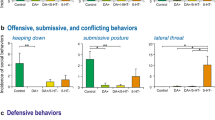Abstract
5,7-Dihydroxytryptamine (250 µg) was administered intracerebroventricularly to rats to lesion central serotonergic neurones. Fourteen days later the rats were tested in the elevated plus-maze “anxiety” model in comparison to sham lesioned animals. Twenty-four hours later, the rats were killed and serotonin levels and [3H]paroxetine binding measured in cortical and hippocampal membranes. The lesion destroyed 81% of the serotonergic innervation in the cortex and 99% in the hippocampus as determined by endogenous serotonin levels. Lesioned rats had an increased ratio of open/total arm entries in the elevated plus-maze, reflecting a decreased level of “anxiety”. These results are compatible with the implication of serotonin in the control of anxiety and suggest that an anxiolytic effect may be induced by lowering the level of serotonergic activation.
Similar content being viewed by others
References
Bradford MM (1976) A rapid and sensitive method for the quantitation of microgram quantities of protein utilizing the principle of protein-dye binding. Anal Biochem 72:248–254
Carli M, Prontera C, Samanin R (1989) Evidence that central 5-hydroxytryptaminergic neurones are involved in the anxiolytic activity of buspirone. Br J Pharmacol 96:829–836
Charney DS, Woods SW, Goodman WK, Heninger GR (1987) Serotonin function in anxiety II. Effects of the serotonin agonist MCPP in panic disorder patients and healthy subjects. Psychopharmacology 92:14–24
Chopin P, Briley M (1987) Animal models of anxiety: the effect of compounds that modify 5-HT neurotransmission. TIPS 8:383–388
Critchley MAE, Handley SL (1989) Dorsal raphe lesions abolish effects of 8-OH-DPAT and ipsapirone in X-maze. Br J Pharmacol 96:309P
File SE, Hyde JRG, Macleod NK (1979) 5,7-Dihydroxytryptamine lesions of dorsal and median raphe nuclei and performance in the social interaction test of anxiety and in a home cage aggression test. J Affective Disord 1:115–122
Fischette CT, Nock B, Renner K (1987) Effects of 5,7-dihydroxytryptamine on serotonin1 and serotonin2 receptors throughout the rat central nervous system using quantitative autoradiography. Brain Res 421:263–279
Habert E, Graham D, Tahraoui L, Claustre Y, Langer SZ (1985) Characterization of [3H]paroxetine binding to rat cortical membranes. Eur J Pharmacol 118:107–114
Kahn RS, Westenberg HGM (1985)l-5-Hydroxytryptophan in the treatment of anxiety disorders. J Affective Disord 8:197–200
Lippa AS, Nash PA, Greenblatt EN (1979) Preclinical neuropsychopharmacological testing procedures for anxiolytic drugs. In: Fielding S, Lal H (eds) Anxiolytics, industrial pharmacology. Futura, New York, pp 3–41
Pellow S, Chopin P, File SE, Briley M (1985) Validation of open: closed arm entries in an elevated plus-maze as a measure of anxiety in the rat. J Neurosci Methods 14:149–167
Thiébot MH, Hamon M, Soubrié P (1982) Attenuation of induced-anxiety in rats by chlordiazepoxide: role of raphe dorsalis benzodiazepine binding sites and serotoninergic neurons. Neuroscience 7:2287–2294
Thiébot MH, Soubrié P, Hamon M, Simon P (1984) Evidence against the involvement of serotonergic neurons in the anti-punishment activity of diazepam in the rat. Psychopharmacology 82:355–359
Tye NC, Evritt BJ, Iversen SD (1977) 5-Hydroxytryptamine and punishment. Nature 268:741–743
Tye NC, Iversen SD, Green AR (1979) The effects of benzodiazepines and serotonergic manipulations on punished responding. Neuropharmacology 18:689–695
Wise CD, Berger BD, Stein L (1972) Benzodiazepines: anxiety-reducing activity by reduction of serotonin turnover in the brain. Science 177:180–183
Author information
Authors and Affiliations
Rights and permissions
About this article
Cite this article
Briley, M., Chopin, P. & Moret, C. Effect of serotonergic lesion on “anxious” behaviour measured in the elevated plus-maze test in the rat. Psychopharmacology 101, 187–189 (1990). https://doi.org/10.1007/BF02244124
Received:
Revised:
Issue Date:
DOI: https://doi.org/10.1007/BF02244124



